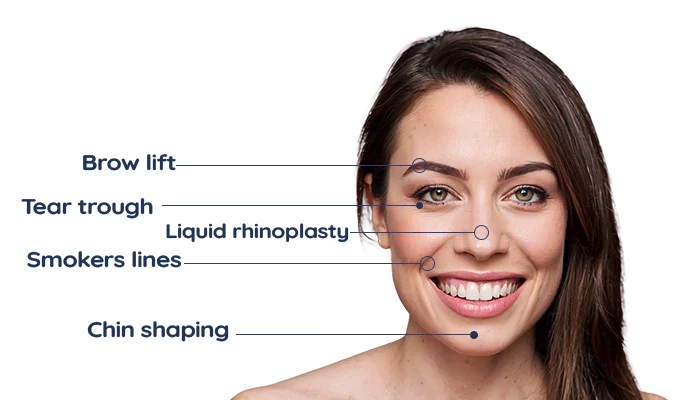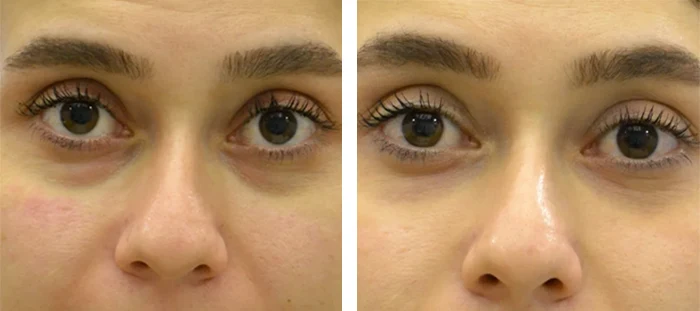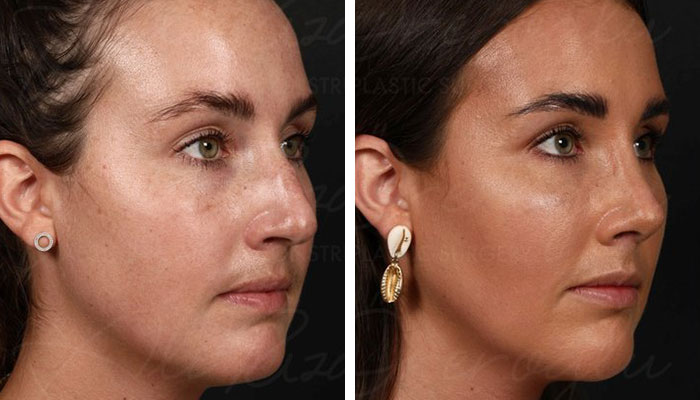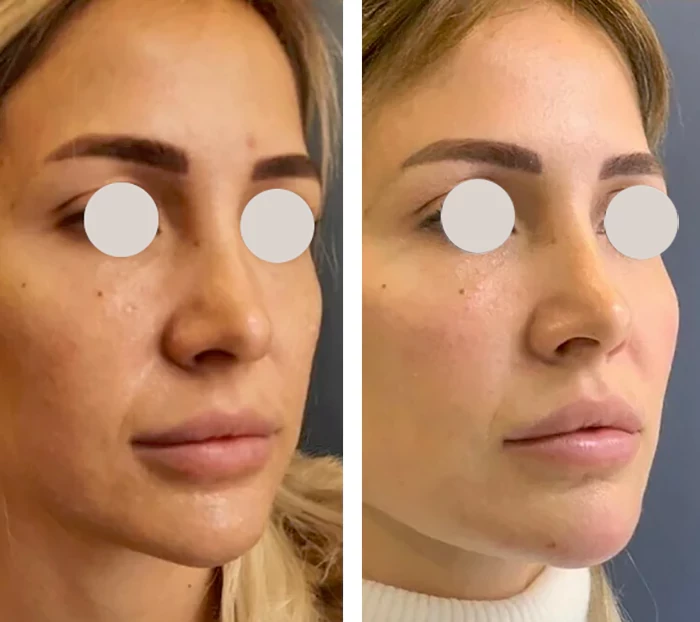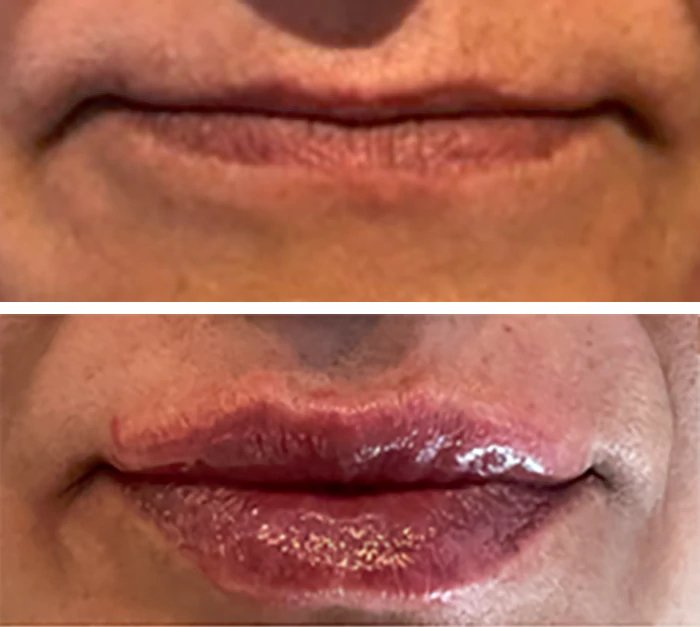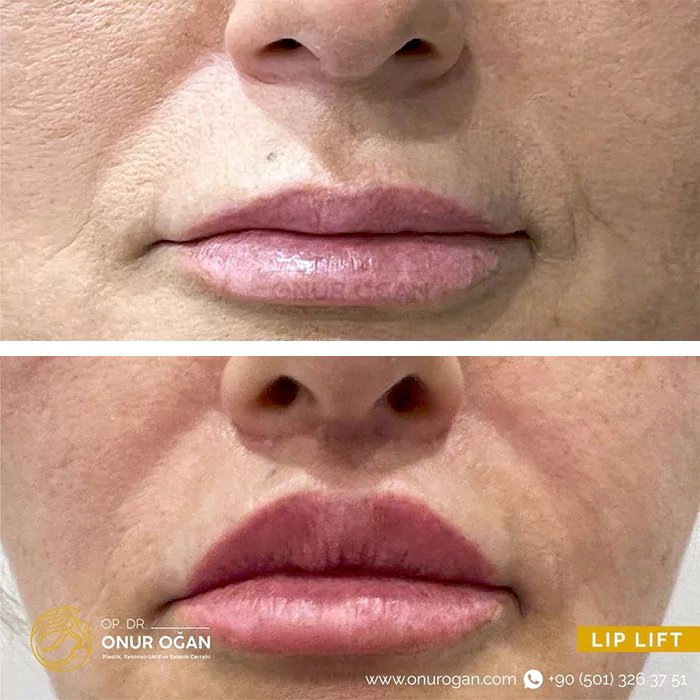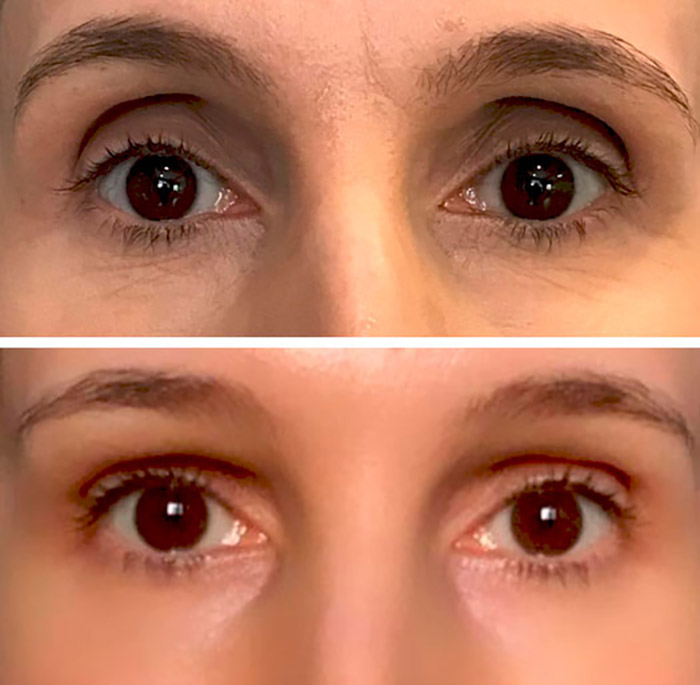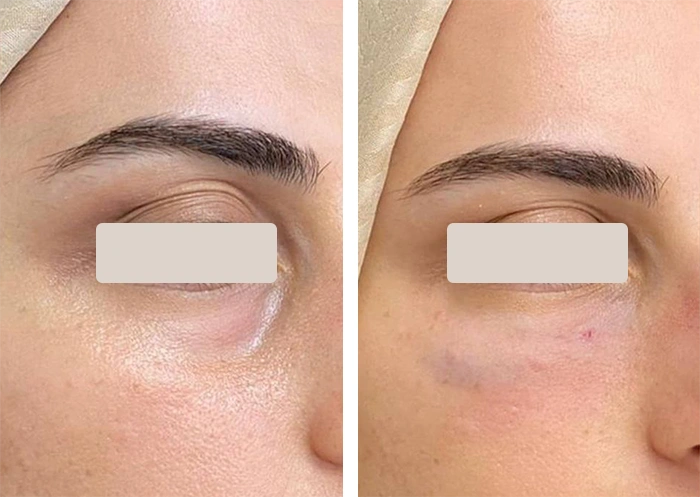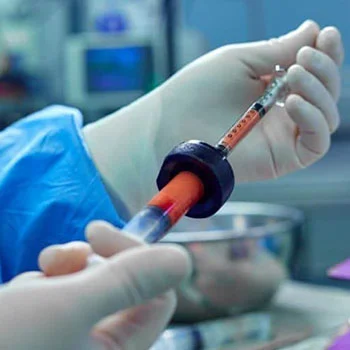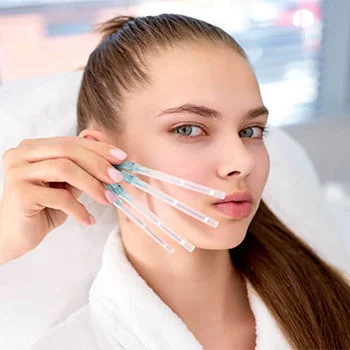An introduction to dermal fillers
Dermal fillers, also known as injectable fillers, have become increasingly popular in recent years as a non-surgical cosmetic treatment option for facial rejuvenation. They are injectable substances that can be used to restore volume, smooth out wrinkles and fine lines, and enhance facial contours.
Dermal fillers are primarily used to address signs of aging, such as volume loss, sagging skin, and deep facial creases. They can also be utilized for non-surgical nose reshaping, lip augmentation, and scar revision.
The primary purpose of dermal fillers is to add volume and structure to areas of the face that have lost elasticity and fat over time. This loss of volume can result in the formation of wrinkles, folds, and hollowed-out areas. By injecting dermal fillers into these areas, the skin is plumped up, smoothening out lines and restoring a more youthful appearance.
Different types of dermal fillers are available, with hyaluronic acid, calcium hydroxylapatite, and poly-L-lactic acid being the most commonly used substances. Each filler has its own unique properties, longevity, and suitability for specific areas of the face.
Dermal filler treatments are typically performed by trained medical professionals, such as dermatologists or plastic surgeons, who have a thorough understanding of facial anatomy and injection techniques. The procedure is usually quick, with minimal downtime and immediate results.
What are the types of dermal fillers?
There are several types of dermal fillers available, each with its own unique composition and characteristics. The most commonly used types of dermal fillers include:
Hyaluronic acid fillers
Hyaluronic acid (HA) is a naturally occurring substance in the body that helps retain moisture and provide volume to the skin. HA fillers are gel-like substances that mimic the body's own hyaluronic acid. They are versatile and can be used to address various concerns, such as smoothing wrinkles, adding volume, and enhancing facial contours. Examples of HA fillers include Juvederm, Restylane, and Belotero.
Calcium hydroxylapatite fillers
Calcium hydroxylapatite (CaHA) is a mineral-like compound found in bones. When used as a dermal filler, it stimulates collagen production and provides immediate volume. CaHA fillers are commonly used for deep creases and folds, such as nasolabial folds and marionette lines. The effects of CaHA fillers can last longer compared to HA fillers. Radiesse is a well-known brand of CaHA filler.
Poly-L-lactic acid fillers
Poly-L-lactic acid is a biocompatible and biodegradable synthetic substance. It works by stimulating collagen production and gradually replacing lost volume. Poly-L-lactic acid fillers are often used for treating larger areas of volume loss, such as sunken cheeks or temples. Sculptra is a popular brand of poly-L-lactic acid filler.
Polymethylmethacrylate fillers
Polymethylmethacrylate (PMMA) is a synthetic, non-biodegradable substance. It is a filler material that is mixed with collagen to create a semi-permanent or permanent filler. PMMA fillers are typically used for deep, permanent correction of wrinkles, scars, or augmentation of facial features. Bellafill is an example of a PMMA filler.
It is important to note that the choice of dermal filler depends on various factors, including the specific concern being addressed, the desired outcome, and the individual's unique facial anatomy. A qualified medical professional will assess your needs and recommend the most suitable type of filler for your desired results.
Additionally, there are other less commonly used dermal fillers, such as autologous fat injections (using the patient's own fat), collagen-based fillers, and newer innovative options that may be available. It is best to consult with a trained professional to determine the most appropriate dermal filler for your specific goals and concerns.
What are the benefits and uses of dermal fillers?
Dermal fillers offer a range of benefits and have various uses in the field of cosmetic medicine. They have various approved and unapproved uses, depending on the specific product and its approval status by regulatory authorities such as the U.S. Food and Drug Administration (FDA) or other governing bodies. Here are some examples:
Approved uses of dermal fillers:
- Softening facial wrinkles and lines: Many injectable fillers are approved for the treatment of facial wrinkles and lines, such as nasolabial folds (smile lines) and marionette lines.
- Lip augmentation: Certain fillers are approved for enhancing the shape and volume of the lips, providing a fuller appearance.
- Cheek augmentation: Some dermal fillers are approved for restoring volume to the cheeks, improving contour, and addressing age-related volume loss.
- Scar revision: Specific types of fillers have FDA approval for minimizing the appearance of certain types of scars, including acne scars.
- Hand rejuvenation: Certain fillers are approved for adding volume to the hands, reducing the visibility of tendons and veins, and restoring a more youthful look.
Unapproved uses of dermal fillers:
- Non-surgical rhinoplasty: Using dermal fillers for non-surgical nose reshaping is an unapproved use. Although it is commonly performed, it is considered an off-label use.
- Chin augmentation: Enhancing the projection and shape of the chin with fillers is an unapproved use and falls under off-label usage.
- Temple augmentation: Filling the temples to address hollowing or sunken appearance is also an off-label use of dermal fillers.
- Jawline contouring: Altering the shape or contour of the jawline with fillers is an unapproved use and is considered off-label.
- Breast or buttock augmentation: Using injectable fillers for breast or buttock augmentation is not approved and is considered an off-label use.
It's important to note that while off-label uses of dermal fillers are commonly performed by experienced and qualified healthcare professionals, they involve using the product in ways not specifically approved by regulatory authorities. It's crucial to consult with a skilled healthcare provider who can assess your specific needs and discuss the potential risks and benefits of any treatment.
What dermal fillers can’t do
Dermal fillers can achieve various aesthetic enhancements and address specific concerns. In a nutshell, dermal fillers can:
- Restore volume
- Smooth wrinkles and fine lines
- Enhance facial contours
- Improve lip fullness and shape
- Correct certain types of scars
However, it is important to understand that dermal fillers are not a good solution to certain cosmetic concerns and have some limitations. Here are what injectable fillers cannot do.
- Treat dynamic wrinkles: Dermal fillers are not effective in treating dynamic wrinkles, which are caused by muscle movement (e.g., crow's feet or forehead lines). Dynamic wrinkles are better addressed with treatments like Botox or Dysport, which relax the underlying muscles.
- Address excessive sagging or skin laxity: Dermal fillers cannot effectively address severe sagging or skin laxity. In cases where significant skin sagging is present, surgical procedures such as facelifts or neck lifts may be more suitable.
- Change bone structure: Dermal fillers cannot alter the underlying bone structure of the face. They can only enhance and restore volume to the soft tissues above the bone. Procedures such as surgical rhinoplasty or chin implants are necessary to modify the bone structure.
- Provide permanent results: injectable fillers are temporary in nature and their effects typically last from several months to a couple of years, depending on the specific filler used. To maintain the desired results, repeat treatments are usually required.
It is important to have realistic expectations and consult with a qualified medical professional to determine the appropriate use of dermal fillers for your specific concerns and goals. They can provide a comprehensive assessment and recommend the most suitable treatment options to achieve the desired outcomes.
Who are good candidates for dermal fillers?
Dermal fillers are suitable for a wide range of individuals who are looking to address specific concerns or enhance their facial features. However, it is important to note that suitability may vary depending on individual factors and the specific type of dermal filler being considered. Here are some general guidelines on who may benefit from injectable fillers:
- Individuals with age-related concerns: Dermal fillers are commonly used to address signs of aging, such as wrinkles, fine lines, and loss of volume. They can be suitable for individuals who want to rejuvenate their appearance and achieve a more youthful look.
- Those with volume loss: As we age, we may experience a loss of volume in certain areas of the face, leading to a sunken or hollowed-out appearance. Dermal fillers can be suitable for individuals looking to restore volume and plumpness in areas such as the cheeks, temples, or under-eye hollows.
- Individuals with thin lips or lip asymmetry: Dermal fillers can be used to enhance the lips and improve symmetry. They are suitable for individuals who desire fuller, more defined lips or want to correct lip asymmetry.
- Individuals with depressed scars: injectable fillers can be utilized to improve the appearance of certain types of scars, such as acne scars or depressed scars. They can help fill in the depressed areas and make the scars less noticeable.
- Individuals with minor nose imperfections: Dermal fillers offer a non-surgical alternative for individuals who want to correct minor imperfections or asymmetries in the nose. This can be suitable for those who desire a more balanced nasal appearance without undergoing traditional surgical rhinoplasty.
It is important to note that while many individuals can benefit from dermal fillers, there may be certain contraindications and precautions to consider. For example, pregnant or breastfeeding individuals, those with active infections or skin diseases, or individuals with allergies or sensitivities to the filler components may not be suitable candidates for dermal filler treatments. It is crucial to consult with a qualified medical professional who can assess your individual circumstances and determine if dermal fillers are appropriate for you.
What to expect before the procedure
Before undergoing a dermal filler procedure, there are a few things you can expect to ensure a smooth and successful experience. Here are some key aspects to consider:
- Consultation: Prior to the procedure, you will typically have a consultation with the medical professional who will be administering the injectable fillers. During this consultation, you will discuss your concerns, goals, and medical history. The medical professional will evaluate your facial anatomy, assess your suitability for the treatment, and determine the most appropriate type and amount of dermal filler for your specific needs.
- Pre-treatment instructions: The medical professional will provide you with specific pre-treatment instructions to follow. These instructions may include avoiding certain medications or supplements that can increase the risk of bleeding, such as aspirin or nonsteroidal anti-inflammatory drugs (NSAIDs). It is important to disclose any medications or supplements you are currently taking during the consultation. It is crucial to inform the medical professional about any known allergies or sensitivities you have, especially to any substances commonly found in dermal fillers. This will help ensure the appropriate filler is selected to minimize the risk of an allergic reaction.
- Numbing: Depending on the specific filler being used and your comfort level, the medical professional may apply a topical anesthetic or administer a local anesthetic injection to numb the treatment area. This helps minimize any discomfort or pain during the procedure.
- Treatment plan: The medical professional will discuss the treatment plan with you, including the areas that will be treated, the amount of filler that will be used, and the expected outcomes. They may also provide you with before-and-after photos or examples of previous patients to help manage expectations.
- Preparation and aftercare: The medical professional may advise you to avoid certain activities, such as alcohol consumption, strenuous exercise, or exposure to excessive heat or sunlight, before the procedure. They may also provide specific instructions for post-treatment care, such as applying ice packs to minimize swelling or avoiding certain skincare products.
It is important to communicate openly with the medical professional during the consultation and follow their instructions to ensure a safe and successful procedure. They will address any concerns or questions you may have and provide personalized guidance based on your individual needs and goals.
Please note that the specific instructions and preparations may vary depending on the medical professional's recommendations, the type of dermal filler used, and your unique circumstances. It is essential to consult with a qualified and experienced practitioner for accurate and tailored guidance before undergoing any cosmetic procedure.
What to expect during the procedure
The procedure for administering dermal fillers is typically performed by a trained medical professional, such as a dermatologist or plastic surgeon, in a clinical setting. Here is a general overview of how the procedure is typically performed:
- Consultation: Before the procedure, you will have a consultation with the medical professional to discuss your concerns, goals, and medical history. They will evaluate your facial anatomy and determine the most appropriate type and amount of dermal filler for your specific needs.
- Preparing the treatment area: The treatment area will be cleansed and may be numbed with a topical anesthetic or a local anesthetic injection, depending on the specific filler being used and your comfort level.
- Injection technique: The medical professional will use a fine needle or a cannula (a thin, flexible tube) to inject the dermal filler into the targeted areas. They will carefully consider the depth and placement of the injections to achieve the desired results. The injections may be preceded by a gentle massage to ensure even distribution of the filler.
- Monitoring and adjustments: Throughout the procedure, the medical professional will closely monitor the results and make any necessary adjustments to ensure symmetry and natural-looking outcomes. They may ask you to provide feedback during the procedure to ensure your satisfaction.
- Treatment duration: The duration of the procedure can vary depending on the areas being treated and the complexity of the treatment plan. In general, dermal filler procedures can typically be completed within 30 minutes to an hour.
- Post-treatment care and recovery: After the injections, you may experience some redness, swelling, or bruising in the treated areas. This is normal and typically subsides within a few days. Your medical professional may provide specific post-treatment instructions, such as avoiding certain activities, applying ice packs, or using specific skincare products.
- Follow-up visits: Depending on the type of filler used and the individual's response to the treatment, follow-up visits may be scheduled to monitor the results and determine if additional treatments or touch-ups are needed.
What to expect after the procedure
After a dermal filler procedure, it is important to have a clear understanding of what to expect in terms of recovery and post-procedure care. Here are some key points to keep in mind:
1- Immediate effects: You will notice immediate results after the dermal filler injections. However, it is important to remember that there may be some initial swelling, redness, or bruising in the treated areas. This is normal and typically resolves within a few days.
2- Post-treatment care: The medical professional will provide you with specific post-treatment instructions to follow. These instructions may include:
- Applying ice packs to the treated areas to help reduce swelling.
- Avoiding touching or applying pressure to the treated areas for the first few days.
- Avoiding strenuous exercise, excessive heat, or sun exposure for a few days.
- Using gentle skincare products and avoiding harsh chemicals or exfoliants on the treated areas.
- Taking any prescribed medications or following any additional instructions given by the medical professional.
3- Swelling and bruising: Swelling and bruising are common side effects after injectable filler injections. The extent and duration of swelling and bruising can vary depending on the individual and the specific filler used. It is normal for these effects to gradually subside within a few days to a week.
4- Results and follow-up: The initial results of the dermal filler treatment can be seen immediately, but they may evolve over the following days as any swelling subsides. The final results are typically fully visible within a couple of weeks. If needed, the medical professional may schedule a follow-up visit to assess the results and determine if any touch-ups or additional treatments are necessary.
5- Longevity of results: The duration of the results will depend on the specific type of dermal filler used. Some fillers last several months, while others can provide results for a year or more. Your medical professional can provide an estimate of how long the results are expected to last based on the specific filler used and your individual circumstances.
Remember that everyone's experience with dermal fillers may vary, and it is crucial to follow the guidance provided by your medical professional for optimal results and to minimize any potential risks or complications. If you have any concerns or questions during the recovery period, do not hesitate to reach out to your medical professional for guidance and support.
What are the risks and side effects?
Dermal filler procedures are generally safe when performed by a qualified medical professional. However, like any medical procedure, there are potential risks and side effects to be aware of. These can include:
- Injection-related side effects: Immediately after the procedure, it is common to experience some injection-related side effects, such as:
Swelling: Mild to moderate swelling is a common side effect and typically subsides within a few days.
Bruising: Bruising at the injection sites may occur, especially if blood vessels are inadvertently punctured during the procedure. This usually resolves within a week.
Redness and Sensitivity: The treated areas may appear red and feel sensitive for a short period, usually resolving within a few days.
- Allergic reactions: Although rare, allergic reactions to injectable fillers can occur. It is essential to disclose any known allergies or sensitivities to the medical professional before the procedure. Signs of an allergic reaction may include swelling, redness, itching, hives, or difficulty breathing. If you experience any of these symptoms, seek immediate medical attention.
- Infection: Infections are rare but can occur at the injection sites. It is crucial to follow proper post-treatment care instructions and keep the treated areas clean to minimize the risk of infection. Signs of infection may include increased pain, swelling, redness, warmth, or discharge. If you suspect an infection, contact your medical professional promptly.
- Nodules or lumps: Occasionally, small nodules or lumps may form beneath the skin at the injection sites. These are typically temporary and can be massaged or treated by the medical professional to improve their appearance.
- Vascular Complications: In rare cases, the filler material may be inadvertently injected into a blood vessel, leading to complications such as tissue damage or skin necrosis (tissue death). Proper injection techniques and a thorough understanding of facial anatomy help minimize this risk. If you experience severe pain, skin discoloration, or any signs of tissue damage, seek immediate medical attention.
- Asymmetry or overcorrection: Achieving perfect symmetry is challenging, and there is a small risk of uneven or overcorrected results. This can usually be addressed during follow-up visits with the medical professional.
It is crucial to choose a qualified and experienced medical professional for dermal filler procedures to minimize the risk of complications. They will have a thorough understanding of facial anatomy, injection techniques, and the appropriate use of dermal fillers.
During your consultation, discuss any concerns or questions you have with the medical professional. They will provide you with personalized information about the specific risks and side effects associated with the dermal filler being used and help you make an informed decision.
Dermal fillers cost
The cost of dermal filler procedures can vary depending on several factors, including the type and amount of filler used, the expertise of the medical professional, the geographic location, and the specific clinic or facility you choose. Generally, the cost is determined by the number of syringes or units of filler needed to achieve the desired results.
On average, the cost of dermal fillers can range from $500 to $1,500 per syringe or unit. However, it is important to note that this is a rough estimate, and prices can vary significantly. Some clinics may offer package deals or discounts for multiple syringes or multiple treatment areas.
It is important to consider that the cost of the procedure is not the only factor to consider when choosing a medical professional. The experience, qualifications, and reputation of the practitioner should also be taken into account to ensure safe and effective results.
During your consultation, the medical professional will provide you with a personalized treatment plan and discuss the associated costs. They will also be able to provide you with more accurate pricing information based on your specific needs and goals.
It is advisable to consult with multiple reputable practitioners to compare prices, credentials, and patient reviews before making a decision. Remember that choosing a qualified and experienced medical professional is crucial to ensure the best outcomes and minimize potential risks or complications.
Poplular dermal filler brands
There are several popular dermal filler brands that are commonly used by healthcare professionals. Some of the most well-known and widely used dermal filler brands include:
- Restylane: Restylane is a popular brand that offers a range of hyaluronic acid-based fillers to address various concerns, such as smoothing wrinkles, enhancing lips, and restoring volume to the face.
- Juvederm: Juvederm is another widely recognized brand offering hyaluronic acid fillers. They have different formulations designed to target specific areas, including the lips, cheeks, and facial lines.
- Radiesse: Radiesse is a calcium hydroxylapatite-based filler that provides both immediate volume and stimulates collagen production for longer-lasting results. It is often used to treat deeper wrinkles and restore facial volume.
- Sculptra: Sculptra is a poly-L-lactic acid-based filler that stimulates collagen production over time. It is typically used for restoring volume to the face, particularly for individuals with significant volume loss.
- Belotero: Belotero is a hyaluronic acid filler that is known for its versatility in treating fine lines and wrinkles in delicate areas, such as around the eyes and mouth.
These are just a few examples of popular dermal filler brands. It's important to note that the choice of filler depends on individual needs, desired outcomes, and the recommendation of a qualified healthcare professional who can assess your specific concerns and determine the most suitable product for you.
FAQs
How long do dermal fillers last?
Dermal fillers typically last between several months to over a year, depending on factors such as the type of filler used and individual factors. Repeat treatments are usually needed to maintain the desired results.
Are dermal fillers better than Botox?
Dermal fillers and Botox serve different purposes and are used to address different concerns. Dermal fillers are primarily used to add volume and fill in wrinkles or areas of lost volume, while Botox is used to temporarily relax muscles and reduce the appearance of wrinkles caused by repetitive facial movements. The choice between injectable fillers and Botox depends on the specific concerns and desired results of each individual
Is a dermal filler injection painful?
Most patients report minimal discomfort during the procedure because healthcare professionals often use topical numbing creams or apply ice to the area prior to the injection to help minimize any potential pain. Additionally, many dermal fillers contain a local anesthetic called lidocaine, which can further reduce discomfort during the injection. Overall, the procedure is generally well-tolerated, and any pain or discomfort is typically brief and temporary.
What is the difference between Restylane and Juvederm?
Restylane and Juvéderm are both popular brands of dermal fillers. The main differences between them lie in their composition, consistency, duration of results, product range, and manufacturer. Restylane uses non-animal stabilized hyaluronic acid (NASHA) and generally has a slightly firmer gel-like consistency, while Juvéderm uses cross-linked hyaluronic acid and is often described as smoother and more malleable. Juvéderm may provide longer-lasting results, with effects lasting up to 12-24 months, compared to Restylane's 6-12 months. Both brands offer various products for different treatment areas and concerns. Restylane is manufactured by Galderma, while Juvéderm is manufactured by Allergan.
Can dermal fillers be removed?
Yes, dermal fillers can be removed, but the process and feasibility depend on the type of filler used. Hyaluronic acid-based fillers, such as Restylane and Juvéderm, can be partially or completely dissolved using an enzyme called hyaluronidase. This enzyme breaks down the hyaluronic acid in the filler, allowing it to be metabolized and absorbed by the body.
However, not all dermal fillers can be easily reversed or removed. Permanent or semi-permanent fillers, such as those containing polymethyl methacrylate (PMMA) or poly-L-lactic acid (PLLA), cannot be dissolved with hyaluronidase. These types of fillers are designed to provide longer-lasting results and are more challenging to remove. In some cases, surgical intervention may be necessary to remove or correct these fillers if desired.

